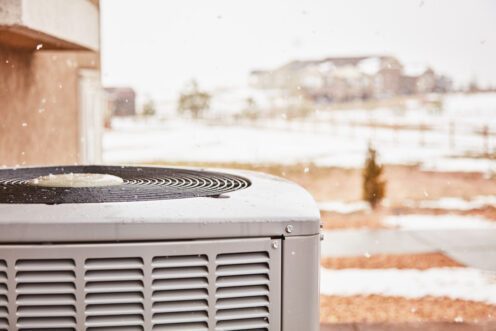
Winter weather in East Peoria, IL and the surrounding areas is consistently cold. Few days see the mercury rise above freezing, and many residential heating systems are constantly running. With the U.S. Department of Energy (DOE) reporting HVAC use as accounting for nearly 50% of the average energy bill, testing the efficiency of your home’s energy usage is a must. Fortunately, there are six easy ways to spot energy waste and resolve it.
1. Schedule Annual Heater Maintenance
Having your home heating equipment professionally maintained is the easiest and most effective way to limit energy waste throughout the cold season. Our technicians inspect and replace HVAC air filters, clean out buildups of interior dust and other debris, replace worn and broken components, and test all safety features. We also calibrate thermostats and estimate the remaining lifespans of heaters. If small or developing problems exist, we address them right away.
2. Seal Air Leaks
Seal up air leaks in building materials by searching for both visible openings and drafts. You can use caulk and weatherstripping to keep the warm air your heater produces trapped indoors. Winter is also a good time to add more insulation to your home while targeting insulating materials with higher R values.
Avoid Making Your Home’s Envelope Too Tight
When taking these and other efficiency measures, try to avoid over-tightening your home’s envelope. This is especially important if you use oil-fired or natural gas-fired appliances that produce exhaust. To limit the risk of dangerous back-drafting events and ensure continuous air exchange that brings in fresh, clean air from outside, keep your bathroom exhaust fans and range hood vent clean, use them often, and invest in additional mechanical ventilation.
3. Have Your HVAC Air Ducts Inspected
Just as important as annual AC and heater tune-ups are yearly ductwork inspections. If your HVAC equipment’s air distribution system is riddled with tears, perforations, or other air leaks, much of your conditioned air will be deposited in crawlspaces, your attic, the basement, or behind your drywall.
Turn Your Heater on and Check for Hot Spots
Another way to check for leaky air ducts is by turning your heater on, letting it run for several minutes, and then placing your hands on several interior walls. If the ducting behind these walls is leaking hot air, they’ll feel increasingly warm to the touch even as the temperature around you remains unchanged.
4. Replace Old, Low-Performing Cooling Equipment
Winter is a great time to replace your air conditioner. With most units lasting between 15 and 20 years, if you haven’t replaced yours in more than two decades, there’s good reason to do so now. With less demand and newer and more efficient models constantly hitting the scene, you can get home cooling equipment with a much higher seasonal energy efficiency ratio (SEER) rating and at a lower cost.
Take Advantage of Our Home Energy Calculator When Shopping
Before choosing a new air conditioner, take advantage of our home energy calculator. This free, online tool will show you how much you can save by opting for higher SEER ratings. It will also help you estimate your break-even point.
All new ACs must have SEER ratings of at least 14. As such, you’ll be hard put to find options that aren’t more efficient than the one you currently own. This remains true even when shopping entry-level models. Best of all, if you opt for a unit with a SEER rating of 16, you could qualify for a significant tax rebate under the 2022 Inflation Reduction Act.
5. Consider Heat Loss Caused by Remote, Underserved Areas
If you have an attic bedroom, attached garage, finished basement, or garden room that’s frequently in use, you may need a secondary heat source for this area. Spaces like these are often unserved or underserved by ducted HVAC systems. Given that warm air tends to migrate towards cooler indoor spaces, installing a ductless mini-split could help you cut your carbon footprint and energy spending. It will also give this space the benefit of improved ventilation, air filtration, and even and consistent heat.
6. Upgrade to a Smart Thermostat
Smart thermostat installation will give you ongoing insights into your energy consumption, HVAC system use, and more. These learning devices track resident behaviors, grow increasingly adept at adjusting themselves, and make it easy to monitor and change temperature settings when you’re not at home. Best of all, many smart thermostats also send out reminders for annual HVAC maintenance and routine air filter changes.
Residents of East Peoria, IL can count on us for cutting-edge IAQ solutions and first-rate heating and cooling installation, maintenance, and repairs. We also provide geothermal heating, fireplaces, and ductless mini-splits. Contact Bratcher Heating & Air Conditioning, Inc. today to schedule an appointment.
